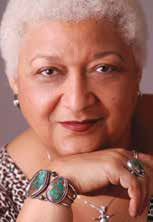
By Jewelle Gomez–
(Editor’s Note: Part 1 ran in the December 3, 2023, issue of the San Francisco Bay Times: https://tinyurl.com/37kzt5vp )
When I left home and moved to NYC in the 1970s, I started to focus on life as a lesbian. I’d always known who I was but there was no one to talk with about it. My great grandmother who raised me and who was born in 1883? Unlikely. My female lover of 4 years, who was straight and then married? Not so much. So, like many, I looked for myself in books.
I had the good fortune to live, for a while, within blocks of the famous store Womanbooks, where I found May Sarton’s Mrs. Stevens Hears the Mermaids Singing. Sarton (1912–1995) was a lesbian and author of 53 books including essays, memoirs, poetry & fiction. Her novel captured my attention because it was about an older woman. Although I was still in my twenties, I’d been raised by an elder and so was entranced by the idea of a 70-year-old bisexual woman who was a poet like me.
Coming of age between the World Wars, Sarton was somewhat circumspect politically. And personally, she could be a bit prickly (I met her once at a conference and had been forewarned). But her sensuous prose and blunt personal manner belied a lust for life. Her character, Old Hilary, is in perpetual debate with herself, Young Hilary, about questions like, “Is fame nothing but a vast debt to be paid?”

A bisexual (how brave of Sarton to publish about it in 1965!), Hilary lives a solitary life, somewhat as Sarton did herself. I remember hoping I’d have the same self-confidence and devotion to my writing: Hilary spends days crafting one line of “that not impossible poem, the thing that would justify it all … .” Yet, the isolation on her land in New England daunted me. Being immersed in birdsong and memories felt like being buried rather than being creative.
Fifty years later and now in my seventies, I read Elisabeth Nonas’ (born in 1949) new novel, Grace Period, whose primary character retires from academia and finds herself suddenly widowed. Like Sarton’s Hilary, Hannah lives in a small town, but she is surrounded by friends, who are sometimes a tidal wave of concern.
There are two differences between these brilliant novels. One is tone. Sarton’s book has sure wit but lands solidly on the side of momentous introspection. In my recent rereading, it made me want to pay closer attention to mundane elements that make up our lives. The joy of bumping into an old friend unexpectedly, or hearing the distant sound of the same train every night before you fall asleep, might shift life 180 degrees.
The underlying tone in the Nonas book is wry humor as she asks her dead wife where to sit the container with her ashes (in the bedroom feels creepy). Can Hannah follow her wishes and scatter the ashes at various locations surreptitiously? As she says, “I’ll just drop your ashes through a hole in my pants pocket. You know, the way prisoners [in the movie The Shawshank Redemption] hide the dirt from the escape tunnel they’re digging.”
Hannah’s observations about the “Vale of Euphemisms,” used to address widows, grates on her and leaves the reader laughing out loud.
Another difference is that Sarton’s Hilary lives in isolation; there’s little sense of community available to her. Still, this gives the reader an opportunity to focus more intently on the elements of Hilary’s life, and in that way, examine our own.
On the other hand, Nonas’ Hannah is steeped in community—academic colleagues, familiar lesbian friends, as well as young lesbians to whom she rents her home. They all insist on connecting with her even when she most needs to be alone. Still, the joy that has been stolen from Hannah remains threaded through her acerbic observations and her kinship circle, making it possible for her to glimpse the life that still lies before her.
Taken together, these two books make being an old lesbian very satisfying.
Jewelle Gomez is a lesbian/feminist activist, novelist, poet, and playwright. She’s written for “The Advocate,” “Ms. Magazine,” “Black Scholar,” “The San Francisco Chronicle,” “The New York Times,” and “The Village Voice.” Follow her on Instagram and Twitter @VampyreVamp
Leave Signs
Published on May 9, 2024
Recent Comments